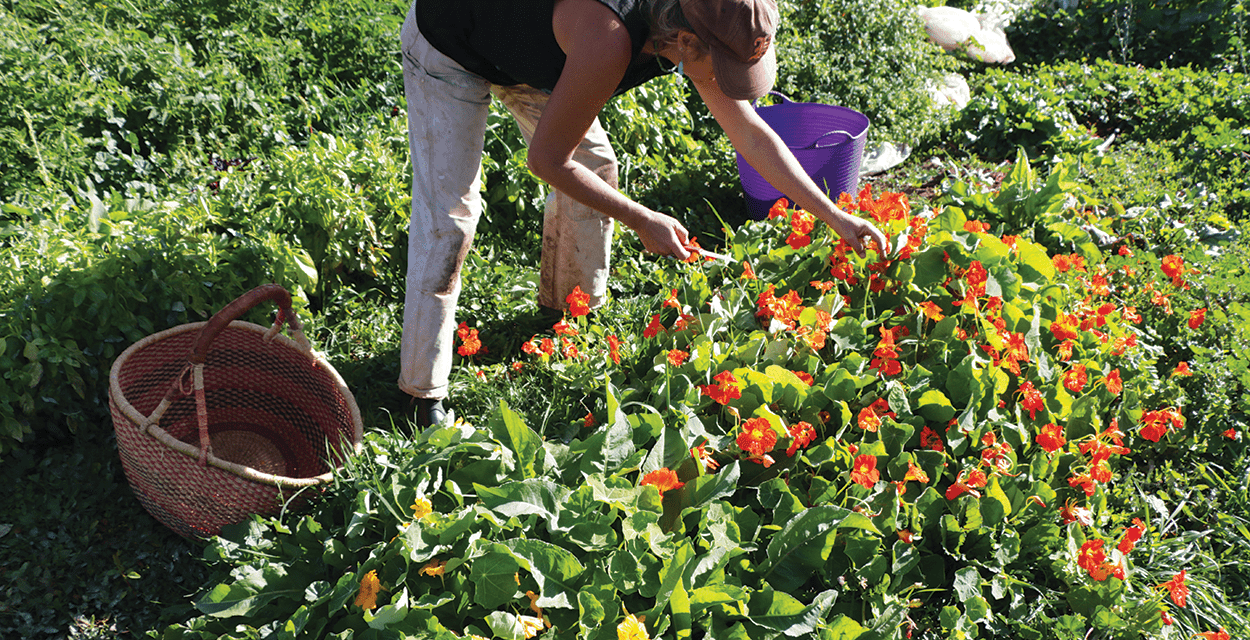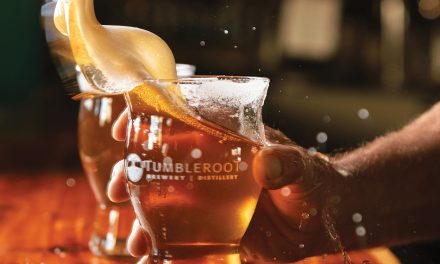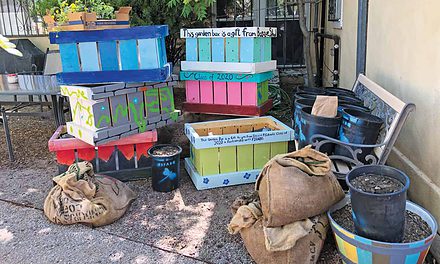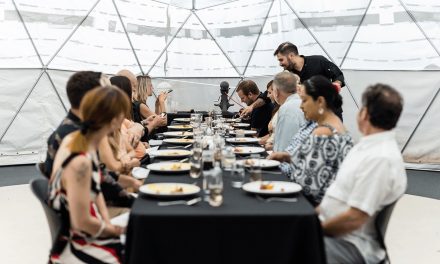Bikes, Brews, and Big Chainrings
By Sarah Wentzel-Fisher

Alta Lakes near Telluride. Photo by Tim Fulton.
On a drizzly July morning last year, I sipped coffee with my sweetheart Zac Fulton and his father, Tim Fulton, at the Laughing Wolf Farm in Mancos, Colorado, as we loaded provisions and camping gear onto bicycles. The sun emerged and a rainbow bloomed over Mesa Verde—an auspicious beginning to our week-long bike tour along the San Juan Skyway.
Most tourists start their journeys on this All-American Road (designated as such in 1996) in Durango, about thirty miles to the east. Most choose automobiles, rather than the much slower two-wheel option, to navigate the 235 miles of high mountain passes (about 16,900 feet of total elevation change) on what is arguably one of the most scenic routes in the country. But the Skyway is also a frequently cycled route, and biking allows for a deeper, more visceral appreciation of the changes in elevation and landscape along the way.
Tourist guides often skip Mancos when describing destinations along the Skyway. This sleepy farm town offers a few decent restaurants and some of the best beer in the region at the local brewery, Mancos Brewing Company. But the real treasures of this place are the farms and the Southwest Farm Fresh Co-op (SWFF), a farmer-owned regional distributor of fresh produce. I mention this at the beginning of this story because it’s where we started and ended our ride, and also as a travel tip—if you really want to eat where local food is served, small food hubs like SWFF offer good insight on where to dine and shop. Often, they will list the restaurants and grocery stores they sell to on their websites, or will happily share this info if you give them a call.
On the first day of our ride, we biked fifty miles. Riding east from Mancos, by mid-morning we had completed our first climb of the journey. A glance back rewarded us with a view of the verdant Mancos Valley perfected by the iconic profile of Mesa Verde. This vista, from a culinary perspective, captures the true beauty and abundance of the region. With high-mountain peaks to store snowpack in cold months, the valley’s fertile soil holds the promise of food.
After a short snack, we mounted up for the speedy descent into Durango. As novice touring cyclists, our food planning was less than perfect. In retrospect, we could have packed less and purchased more along the way, as the route offers a number of great grocery stores, roadside markets, and eateries. In warm months, Durango hosts a sizeable farmers market on Saturday mornings, but year- and week-round, the Durango Natural Food Co-op is an excellent choice to prevent a mid-ride energy crash. Durango also offers a host of great eateries and watering holes, but we still had more than twenty miles, all uphill, before we would set up camp for the night, so our stay in town was brief.

Top left: Guests picnicking at James Ranch. Top right: Veggie burger made with with seasoned, grilled squash and tomatoes. Bottom: James Ranch cows grazing in the valley. Photos courtesy of James Ranch.
The next stretch of the ride provides one of my favorite places to stop in the area: the James Ranch. The ranch, at the top of the irrigation system along the Animas River, is home to beef and dairy cows; a farmstead cheese-making operation; heritage pigs and chickens; a large market garden growing vegetables, flowers, and fruits; a tree farm; an outdoor music venue; a farm market and harvest grill; and three generations of James family members collaborating to manage their four hundred acres of contiguous farmland. For a hungry cyclist in search of local food, this is an ideal stop because both the market and the grill are open every day except Sunday, from 11am to 7pm, in summer months. The grill serves burgers and salads sourced primarily from the ranch, filling any gaps with products from other local farms. The market offers eggs and packaged pork and beef raised right on the ranch; a nice selection of seasonal fresh vegetables; and, the best reason to stop, the family’s award-winning artisanal cheese.
I purchased a half pound each of sweet cherries and mature Belford (my favorite of the five cheeses made by Dan James), and a small bag of mixed salad greens. I hesitated to buy more, knowing that every ounce would make the next ten miles to Haviland Lake, where we would camp for the night, a little more taxing. We reached our campsite at dusk, strolled around the small, stream-fed lake for a change of pace, and watched an ominous bank of clouds roll up the valley. That evening, as we dined on a combination of pre-packaged noodles, delicious cheese, and an undressed pile of greens, I was reminded of two of the tenets of long bike trips: First, when you’ve ridden your bike all day, everything you eat tastes really good; second, sleep comes quickly and easily (especially if rain is pattering against your tent).
Our second day was both the shortest in distance and the most challenging. We had planned to ride past Silverton, just over thirty miles to the Sultan and Anvil Campground, but as we crested Molas Pass at just over ten thousand feet with water bottles emptied and food supplies exhausted, we knew our day had ended. At this point, you may be asking yourself, why didn’t they just stay at a nice B&B? Perhaps it was a point of pride to be able to ride our bikes for a week in a relatively self-sufficient way, carrying our food and camping gear, but even given two easier choices—having our gear waiting for us at a campsite at the end of each day or stopping at inns along the way—I think I would still choose the outdoor option.
Molas Lake campground, operated by the City of Silverton, surrounds a small alpine lake encircled by 14,000-foot snow-capped peaks. We wearily rode into the campground to inquire about a site with little hope that space would be available—during the summer, campers will reserve months in advance. The campground attendants took pity and offered us the last site in the campground, which we gratefully accepted, expecting, perhaps, a view of the outhouse. Instead, our site was nestled along the lake’s edge, with a number of shrubs protecting the space. In the morning, we awoke to a purple dawn mist rising off the lake’s surface and a nearly full moon setting behind it. Even if you drove up on a whim and slept in your back seat, the experience of waking up in this place would be spectacular. Along the Skyway, undesirable campgrounds just don’t exist. Some have more amenities than others—hot showers, wifi, lean-tos—but even the most rudimentary offer stunning and peaceful places to sleep under the stars.

https://www.adventurecycling.org/
Southwest Farm Fresh Co-op getting deliveries out, rain or shine. Photo by Ole Bye.
Day three proved to be one of the longest, but most scenic, taking us seventy-five miles through Silverton, over Red Mountain Pass, through Ouray, over the Dallas Divide, and finally to a campground along the south fork of the San Miguel River. In this part of the San Juans, all abundance and beauty comes from the intense mineralization that inspired gold and silver rushes in the late 1800s and that still inspires some mining when metal prices are high. The stretch of the Skyway between Red Mountain Pass and Ouray, known as the Million Dollar Road, is thirteen miles of tight hairpin turns. Steep rocky walls cut by waterfalls and mining blasts dwarf everything. This area has probably never been nor ever will be known for its cuisine or ingredients. The rocky soil is not the only challenge for gardeners; Ouray has ninety-seven frost-free days, Silverton about ninety, and Telluride just forty-seven. While the high-mountain environment offers some fishing, hunting, and foraging, area mining periodically pollutes the water that supports wildlife in the alpine reaches as well as downstream agriculture.
In spite of an innate inability to grow food, Telluride has no lack of appreciation for good food. A four-season tourist town catering primarily to an affluent clientele, Telluride restaurants import a significant amount of food from distributors like SWFF and area farmers to the north in Norwood, Montrose, and Olathe. When I asked Ole Bye, the director of SWFF, who he sells to in Telluride, he mentioned a number of places, but gave a special nod to La Cocina de Luz. Lucas Price opened the establishment, serving affordable and delicious Southwestern fare, in 1997 after a short stint running a taco cart and studying with Mark Miller at Coyote Café in Santa Fe. From La Cocina’s inception, Price has had good ingredients at the top of his priority list. Today, that means working with Bye to source as many ingredients as possible from local farms sustainably raising fruit, veggies, meat, and more.
When we rode into Telluride on our fourth day, we arrived to flocks of spandex-adorned men and women, a large teepee with artsy furniture in the city park, and a lot of activity. This town often thrums with hubbub, offering one, and sometimes two, festivals a weekend over the summer months (in this case, a yoga festival was ending while the Telluride Art + Architecture Weekend began). For food lovers, I recommend scheduling a visit to coincide with one of the annual Mushroom, Blues and Brews, or Wine festivals, or during their annual Top Chef Competition.
We got a late start out of Telluride, and didn’t know exactly where we would stay that night. We didn’t have the daylight or the energy to make it as far as we’d mapped for the day, but by this point in the trip, we’d learned that the right place would present itself when we needed to stop. We made it to Priest Lake, a rudimentary campground nestled in a valley just three miles from Lizard Head Pass, the point after which the entire trip would be downhill. On a bike tour, day four is when you hit a rhythm. Packing your gear becomes methodical, you realize all the things you shouldn’t have packed because you won’t use them, and your body feels more acclimated to the constant level of activity. Bicycle touring isn’t only for the extremely fit—it’s about balance and pacing. It does not require the kind of endurance and stamina that running does, and on this journey, we saw cyclists of all ages and body types. Climbs take a long time, but if you put your bike in low gear, stop when you need water or a snack, and give yourself plenty of time to get where you’re going, I really believe almost anyone could ride some or all of the San Juan Skyway.
After the short three miles to the summit of Lizard Head Pass, the rest of our day was downhill. Alpine peaks take the breath away, but the scenery of this day’s ride, for me, took the prize. The descent from the pass essentially follows the course of the Dolores River, a mighty sculptress of the canyons of southeastern Utah who terminates at her confluence with the Colorado River, just north of Arches National Park. As the miles passed, the color of the earth shifted to red, the vegetation grew shorter and sparser, and we reached the point where mountains meet canyons and turn into desert.
Our day ended in the town of Dolores, where we stopped to soothe our hot, dry skin in the river. Dolores is an often overlooked destination along the Skyway, but offers much to the curious traveller. In addition to a beautiful river running the course of the town, Dolores is the gateway to several ancient Puebloan ruins, a large reservoir great for fishing and swimming, and, like many stops along the way, home to a fantastic local brewery—the Dolores River Brewery. The brewery offered us a lovely respite from the day with delicious wood-oven pizza and, of course, well-crafted beer.
Beer is an important part of Colorado culture, and the small towns along the Skyway are no exception. Beer and biking complement one another, and can provide for just the right mix of libation and activity. While you could plan your own bike adventure along the Skyway, a supported ride might be a good way to take a first tour. A number of companies, like Lizard Head Cycling Guides, Adventure Cycling, and Beer and Bike Tours, offer supported tours for cyclists. Beer and Bike Tours will take riders’ belongings to destination towns, reserve rooms and provide breakfast, and coordinate tastings at nine breweries over the course of seven days.
Our last stop along the Skyway was in Cortez. Both Mancos and Cortez function as gateways to Mesa Verde, which can be a great additional stop on the ride if you have a few extra days. Cortez clearly came of age during the golden age of the road trip; the main street is filled with 1950s and ‘60s era road motels and diners. While the town mostly caters to nostalgia seekers, it offers a few gems for the cycling locavore like myself. In particular, the Farm Bistro is not to be missed.

Top to bottom: Zac and Sarah riding into Silverton (photo by Tim Fulton); Laughing Wolf Farm (photo by Ole Bye); Lizard Head Pass–It’s all downhill from here (photo courtesy of Tim Fulton).
Opened in 2009 with a farm-to-table mission, the Farm Bistro serves up “comfort food with style.” We stopped for lunch on our last day, as our food stores had dwindled to some dried fruit, oatmeal, and cracker crumbs. Enjoying large salads, and particularly relishing the fresh vegetables after several days without many greens, we read about the restaurant’s commitment to local producers. Their menu boasts that over fifty-five percent of their purchases are made with purveyors in a seventy-five-mile radius. The food is local, and so are the diners. The Farm Bistro offers affordable fare tailored for unpretentious eaters.
Traveling by bicycle through dramatic landscapes like those along the San Juan Skyway can impress you with the necessity of food and water, and their relationship to the land, in immediate and tangible ways. While driving allows you to experience elevation change and to pass through beauty, it doesn’t allow the kind of immediacy, or the direct exposure to the elements, that cycling provides. Traveling across hundreds of miles at a human-powered pace, it’s easier to imagine the decision-making process of ancient and historic people as they migrated to and through these places. Where is there water and shelter? What routes enable safe and navigable passage? And which places will grow or provide food?
On well-traveled routes like the San Juan Skyway, local food provides a different perspective and pleasant surprises. Part of the intrigue of travel is happening upon the unexpected—a great restaurant not mentioned in the travel guide, a community event, a view in a moment of perfect weather and perfect light. In an era when Internet research and online reviews can help you plan a trip in extreme detail, visiting tourist destinations with enough pre-planning for a smooth trip, but not so much that you feel you’ve already seen a place before you get there, can be a hard balance to strike. I often seek out not just the restaurants that source local food or offer regional cuisine, but also the farms that grow it, the distributors who get it there, and the markets where locals shop for ingredients. In the case of this story, both food and the mode of transit made for an unusual and breathtaking experience of the southwestern corner of Colorado.
Beer and Bike Tours
beerandbiketours.com/san-juan-skyway-colorado-adventure
Laughing Wolf Farm www.laughingwolffarm.com
Mancos Brewing Company
www.mancosbrewingcompany.com
Southwest Farm Fresh www.southwestfarmfresh.com
James Ranch www.jamesranch.net
The Farm Bistro www.thefarmbistrocortez.com
Dolores River Brewery www.doloresriverbrewery.com
Durango Natural Foods www.durangonaturalfoods.coop
Molas Lake www.molaslake.com
La Cocina www.lacocinatelluride.com
Festivals
www.telluride.com/telluride-mushroom-festival
www.telluride.com/telluride-blues-brews-festival
www.telluride.com/telluride-wine-festival
www.telluride.com/taste-telluride-and-top-chef-competition
Edible celebrates New Mexico's food culture, season by season. We believe that knowing where our food comes from is a powerful thing. With our high-quality, aesthetically pleasing and informative publication, we inspire readers to support and celebrate the growers, producers, chefs, beverage and food artisans, and other food professionals in our community.












